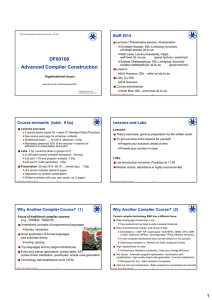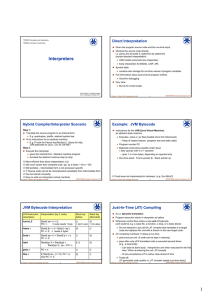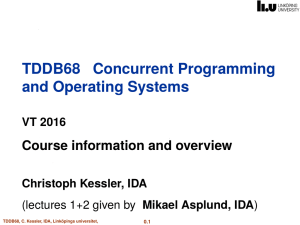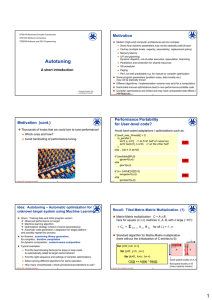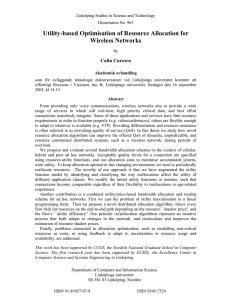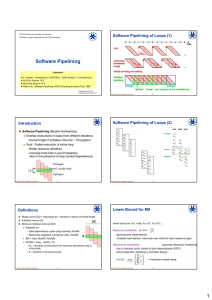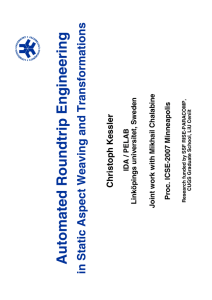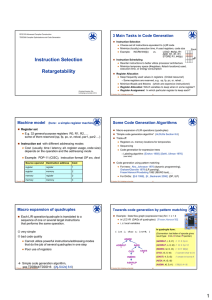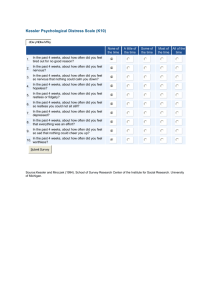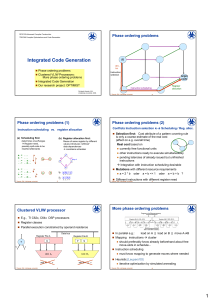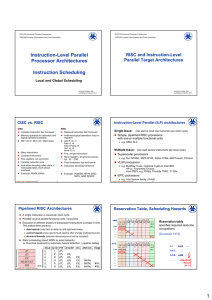Register Allocation
advertisement
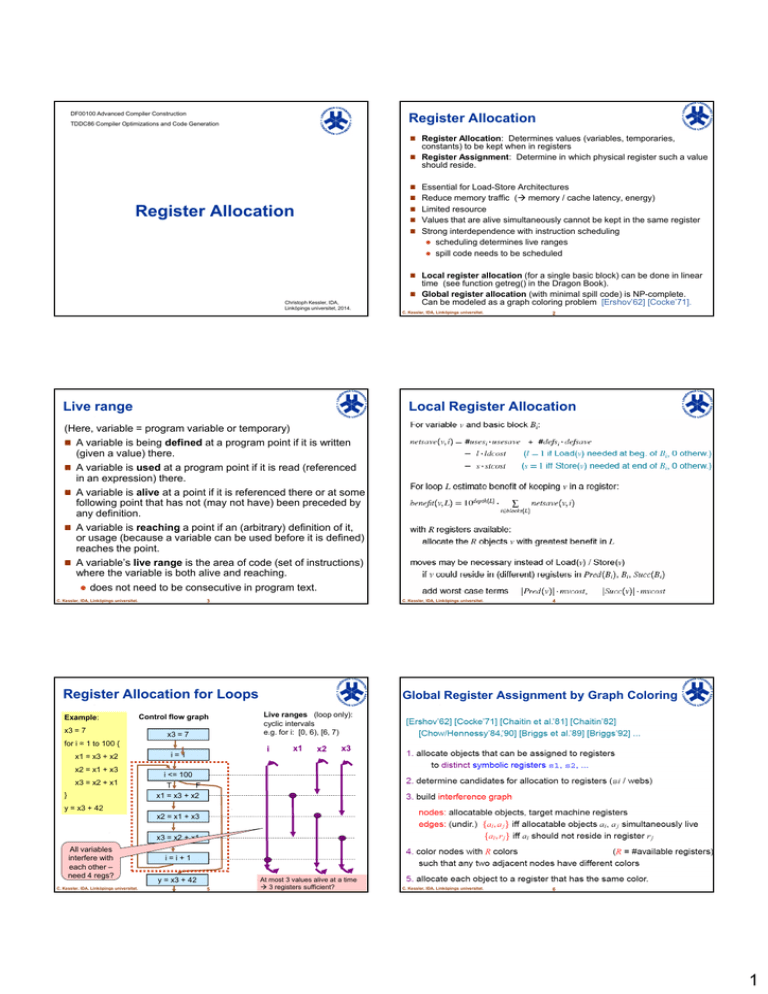
DF00100 Advanced Compiler Construction
Register Allocation
TDDC86 Compiler Optimizations and Code Generation
Register Allocation: Determines values (variables, temporaries,
constants) to be kept when in registers
Register Assignment: Determine in which physical register such a value
should reside.
Essential for Load-Store Architectures
Reduce memory traffic ( memory / cache latency, energy)
Register Allocation
Limited resource
Values that are alive simultaneously cannot be kept in the same register
Strong interdependence with instruction scheduling
scheduling determines live ranges
spill code needs to be scheduled
Local register allocation (for a single basic block) can be done in linear
time (see function getreg() in the Dragon Book).
Global register allocation (with minimal spill code) is NP-complete.
Christoph Kessler, IDA,
Linköpings universitet, 2014.
Live range
Can be modeled as a graph coloring problem [Ershov’62] [Cocke’71].
C. Kessler, IDA, Linköpings universitet.
2
TDDC86 Compiler Optimizations and Code Generation
Local Register Allocation
(Here, variable = program variable or temporary)
A variable is being defined at a program point if it is written
(given a value) there.
A variable is used at a program point if it is read (referenced
in an expression) there.
A variable is alive at a point if it is referenced there or at some
following point that has not (may not have) been preceded by
any definition.
A variable is reaching a point if an (arbitrary) definition of it,
or usage (because a variable can be used before it is defined)
reaches the point.
A variable’s live range is the area of code (set of instructions)
where the variable is both alive and reaching.
does not need to be consecutive in program text.
C. Kessler, IDA, Linköpings universitet.
3
TDDC86 Compiler Optimizations and Code Generation
Register Allocation for Loops
Example:
x3 = 7
Control flow graph
x3 = 7
for i = 1 to 100 {
x1 = x3 + x2
x2 = x1 + x3
x3 = x2 + x1
}
4
TDDC86 Compiler Optimizations and Code Generation
Global Register Assignment by Graph Coloring
Live ranges (loop only):
cyclic intervals
e.g. for i: [0, 6), [6, 7)
i
i=1
C. Kessler, IDA, Linköpings universitet.
x1
x2
x3
i <= 100
T
F
x1 = x3 + x2
y = x3 + 42
x2 = x1 + x3
x3 = x2 + x1
All variables
interfere with
each other –
need 4 regs?
C. Kessler, IDA, Linköpings universitet.
i=i+1
y = x3 + 42
5
At most 3 values alive at a time
3 registers sufficient?
TDDC86 Compiler Optimizations and Code Generation
C. Kessler, IDA, Linköpings universitet.
6
TDDC86 Compiler Optimizations and Code Generation
1
Allocatable objects: Webs (Live ranges)
Register Allocation by Graph Coloring
Step 1: Given a program with symbolic registers s1, s2, ...
C. Kessler, IDA, Linköpings universitet.
7
TDDC86 Compiler Optimizations and Code Generation
Determine live ranges of all variables
C. Kessler, IDA, Linköpings universitet.
8
TDDC86 Compiler Optimizations and Code Generation
Register Allocation by Graph Coloring
Step 3: Color the register interference graph with k colors,
Step 2: Build the Register Interference Graph
Undirected edge connects two symbolic registers (si, sj)
if live ranges of si and sj overlap in time
Reserved registers (e.g. fp) interfere with all si
symbolic registers
physical
registers
where k = #available registers.
If not possible: pick a victim si to spill, generate spill code
(store after def., reload before use)
This may remove some interferences.
Rebuild the register interference graph + repeat Step 3...
This register interference graph cannot be colored
with less than 4 colors, as it contains a 4-clique
C. Kessler, IDA, Linköpings universitet.
9
TDDC86 Compiler Optimizations and Code Generation
C. Kessler, IDA, Linköpings universitet.
10
TDDC86 Compiler Optimizations and Code Generation
Coloring a graph with k colors
Live range coalescing = fusion of webs
NP-complete for k > 3
For a copy instruction
Chromatic number g(G) = minimum number of colors to color a graph G
g(G) > c if the graph contains a c-clique
A c-clique is a completely connected subgraph of c nodes
sj si
where si and sj do not interfere
and si and sj are not rewritten after the copy operation
Merge si and sj:
Chaitin’s heuristic (1981):
S { s1, s2, ... } // set of spill candidates
degree<k rule
while ( S not empty )
choose some s in S.
if s has less than k neighbors in the graph
then // there will be some color left for s:
delete s (and incident edges) from the graph
else modify the graph (spill, split, coalesce ... nodes) changes IR
and restart.
// once we arrive here, the graph is empty:
color the nodes greedily in reverse order of removal.
C. Kessler, IDA, Linköpings universitet.
11
TDDC86 Compiler Optimizations and Code Generation
patch (rename) all occurrences of si to sj
update the register interference graph
and remove the copy operation.
s2 ...
...
s3 s2
...
... s3 ...
C. Kessler, IDA, Linköpings universitet.
s3 ...
...
s3 s3
...
... s3 ...
12
r1 ...
...
...
... r1 ...
TDDC86 Compiler Optimizations and Code Generation
2
Conservative Coalescing
Spilling (1)
Spilling a (physical) register r
= spilling the live range w contained in r
uses some memory location w.tmp
(on stack, scratchpad memory, or w’s home memory
location)
insert a Store r, w.tmp
immediately after each definition of w.var
insert a Load r, w.tmp
immediately before each use of w.var
Some interferences disappear,
the interference graph must be updated.
C. Kessler, IDA, Linköpings universitet.
13
TDDC86 Compiler Optimizations and Code Generation
Spilling (2)
C. Kessler, IDA, Linköpings universitet.
C. Kessler, IDA, Linköpings universitet.
14
TDDC86 Compiler Optimizations and Code Generation
16
TDDC86 Compiler Optimizations and Code Generation
Rematerialization
15
TDDC86 Compiler Optimizations and Code Generation
C. Kessler, IDA, Linköpings universitet.
Spilling (3)
Live Range Splitting
Total spilling eliminates a live range completely
Long live ranges tend to interfere with many others
store after each definition, reload before each use
Partial spilling splits a live range into several ones
Some reduction in interference, some spill code
harder to color.
Idea: Split up long live ranges to avoid some spilling
reg-to-reg copy is much cheaper than memory spill
Live range splitting = the reverse of coalescing
store
load
C. Kessler, IDA, Linköpings universitet.
17
TDDC86 Compiler Optimizations and Code Generation
C. Kessler, IDA, Linköpings universitet.
18
TDDC86 Compiler Optimizations and Code Generation
3
Chaitin’s Register Allocator (1981)
C. Kessler, IDA, Linköpings universitet.
19
Improvement: Optimistic Graph Coloring
TDDC86 Compiler Optimizations and Code Generation
Allocator with Briggs’ improvement
C. Kessler, IDA, Linköpings universitet.
20
TDDC86 Compiler Optimizations and Code Generation
Hierarchical Register Allocation
Callahan, Koblenz
PLDI’91
C. Kessler, IDA, Linköpings universitet.
21
TDDC86 Compiler Optimizations and Code Generation
Hierarchical Register Allocation
top region (procedure)
v1 v2
for (…)
v3 v4
22
TDDC86 Compiler Optimizations and Code Generation
Two-Step Approach
top region (procedure)
v1 v2
spill v1
for (…)
C. Kessler, IDA, Linköpings universitet.
v3 v4
Pre-Spilling phase
Limit the remaining register pressure at any program point
to the available number of physical registers
Can attempt for optimal spilling
Graph-Coloring phase
v5 v6
if 3 physical
regs avail.:
spill v2
reload v1
for (…)
for (…)
Now easier to K-color
v5 v6
Appel,
George PLDI’01
Ebner
2009
reload v2
C. Kessler, IDA, Linköpings universitet.
23
TDDC86 Compiler Optimizations and Code Generation
C. Kessler, IDA, Linköpings universitet.
24
TDDC86 Compiler Optimizations and Code Generation
4
Optimal Spilling?
SSA-Based Register Allocation
Select those live ranges for spilling
For SSA programs, the register interference graph is chordal
whose accumulated spill cost is minimal
Optimal (pre-)spilling and a-posteriori insertion of spill code
Hack,
for given instruction schedule is NP-complete even for basic
blocks
Integer Linear Programming
e.g.
Brisk
Horwitz et al. 1966
et al. 2009: heuristic
Grund,
Most compilers use (greedy) heuristics (see above)
TDDC86 Compiler Optimizations and Code Generation
Fast Register Allocation
Compilation time critical
Linear-Scan Register allocators
Poletto,
Traub,
2009: heuristic
C. Kessler, IDA, Linköpings universitet.
26
TDDC86 Compiler Optimizations and Code Generation
Interdependences
Register Allocation Instruction Scheduling
For JIT compilers:
Hack 2007: Integer Linear Programming
Optimal pre-spilling in SSA programs
Ebner
25
et al. 2006
et al. 2009: Optimistic chordal coloring
Optimal coalescing in spill-free SSA programs
Brisk
Appel, George PLDI 2001
C. Kessler, IDA, Linköpings universitet.
Goos 2006
Bouchez
Dynamic programming
e.g.
Can be K-colored in quadratic time!
(trade-off with code quality)
Sarkar TOPLAS 1999
Holloway, Smith PLDI 1998
C. Kessler, IDA, Linköpings universitet.
27
TDDC86 Compiler Optimizations and Code Generation
C. Kessler, IDA, Linköpings universitet.
28
TDDC86 Compiler Optimizations and Code Generation
5
